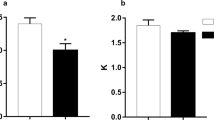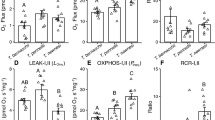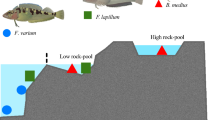Abstract
Previous work in our laboratory showed that levels of oxidized proteins and/or lipids increase in heart ventricles of icefishes but not red-blooded notothenioids in response to exposure to their critical thermal maxima (CTMax). However, neither icefishes nor red-blooded fishes up-regulate their antioxidant defenses in response to exposure to CTMax, suggesting notothenioids may have lost the ability to alter antioxidant levels in response to stress during their evolution at cold temperature. Alternatively, exposure to CTMax may have been too short a thermal stress to induce increases in antioxidant levels. To address this question, the icefish Chionodraco rastrospinosus and the red-blooded notothenioid Notothenia coriiceps were maintained at either 0 ºC or 4 °C for 1 week. Levels of oxidized proteins and lipids, as well as transcript abundance and maximal activity of the antioxidants superoxide dismutase and catalase, were quantified in heart ventricle and pectoral adductor muscle. Although previous studies showed that the production of reactive oxygen species increases in response to warming in notothenioids, neither levels of oxidized proteins, lipids nor antioxidant activity increased in any tissue of either species in response to exposure to 4 °C. This suggests that notothenioids do not incur oxidative damage during prolonged, moderate warming.





Similar content being viewed by others
Explore related subjects
Discover the latest articles and news from researchers in related subjects, suggested using machine learning.References
Abele D, Puntarulo S (2004) Formation of reactive species and induction of antioxidant defence systems in polar and temperate marine invertebrates and fish. Comp Biochem Physiol A Mol Integr Physiol 138:405–415
Abele D, Burlando B, Viarengo A, Pörtner HO (1998) Exposure to elevated temperatures and hydrogen peroxide elicits oxidative stress and antioxidant response in the Antarctic intertidal limpet Nacella concinna. Comp Biochem Physiol B Biochem Mol Biol 120:425–435
Atkinson A, Siegel V, Pakhomov E, Rothery P (2004) Long-term decline in krill stock and increase in salps within the Southern Ocean. Nature 432:100–103
Beers RF Jr, Sizer IW (1952) A spectrophotometric method for measuring the breakdown of hydrogen peroxide by catalase. J Biol Chem 195:133–140
Bilyk KT, DeVries AL (2011) Heat tolerance and its plasticity in Antarctic fishes. Comp Biochem Physiol A Mol Integr Physiol 158:382–390
Bilyk KT, Evans CW, DeVries AL (2012) Heat hardening in Antarctic notothenioid fishes. Polar Biol 35:1447–1451
Bligh EG, Dyer WJ (1959) A rapid method of total lipid extraction and purification. Can J Biochem Physiol 37:911–917
Boveris A, Chance B (1973) The mitochondrial generation of hydrogen peroxide. General properties and effect of hyperbaric oxygen. Biochem J 134:707–716
Brand MD (2000) Uncoupling to survive? The role of mitochondrial inefficiency in ageing. Exp Gerontol 35:811–820
Buckley BA, Somero GN (2009) cDNA microarray analysis reveals the capacity of the cold-adapted Antarctic fish Trematomus bernacchii to alter gene expression in response to heat stress. Polar Biol 32:403–415
Chen Z, Cheng CH, Zhang J, Cao L, Chen L, Zhou L, Jin Y, Ye H, Deng C, Dai Z, Xu Q, Hu P, Sun S, Shen Y (2008) Transcriptomic and genomic evolution under constant cold in Antarctic notothenioid fish. Proc Natl Acad Sci USA 105:12944–12949
Coppe A, Agostini C, Marino IA, Zane L, Bargelloni L, Bortoluzzi S, Patarnello T (2013) Genome evolution in the cold: antarctic icefish muscle transcriptome reveals selective duplications increasing mitochondrial function. Genome Biol Evol 5:45–60
Crapo JD, McCord JM, Fridovich I (1978) Preparation and assay of superoxide dismutases. Method Enzymol 53:382–393
Crockett EL (2011) Antioxidant potential is positively correlated with mitochondrial enzyme activity in Antarctic and non-Antarctic notothenioid fishes. Polar Biol 34:113–118
Detrich HW III (1997) Microtubule assembly in cold-adapted organisms: functional properties and structural adaptations of tubulins from antarctic fishes. Comp Biochem Physiol A Mol Integr Physiol 118:501–513
DeVries AL, Wohlschlag DE (1969) Freezing resistance in some Antarctic fishes. Science 163:1073–1075
Eastman JT (1993) Antarctic fish biology: evolution in a unique environment. Academic Press, San Diego
Enzor LA, Zippay ML, Place SP (2013) High latitude fish in a high CO2 world: synergistic effects of elevated temperature and carbon dioxide on the metabolic rates of Antarctic notothenioids. Comp Biochem Physiol A Mol Integr Physiol 164:154–161
Fields PA, Somero GN (1998) Hot spots in cold adaptation: localized increases in conformational flexibility in lactate dehydrogenase A4 orthologs of Antarctic notothenioid fishes. Proc Natl Acad Sci USA 95:11476–11481
Franklin CE, Davison W, Seebacher F (2007) Antarctic fish can compensate for rising temperatures: thermal acclimation of cardiac performance in Pagothenia borchgrevinki. J Exp Biol 210:3068–3074
Girotti AW (1998) Lipid hydroperoxide generation, turnover, and effector action in biological systems. J Lipid Res 39:1529–1542
Hemmingsen EA, Douglas EL (1972) Respiratory and circulatory responses in a hemoglobin-free fish, Chaenocepahlus aceratus, to changes in temperature and oxygen tension. Comp Biochem Physiol A Mol Integr Physiol 43:1031–1043
Hofmann EE, Klinck JM (1998) Thermohaline variability in the waters overlying the West Antarctic Peninsula Continental Shelf. In: Jacobs S, Weiss R (eds) Ocean, ice and atmosphere: interactions at the Antarctic continental margin, AGU Antarctic Research Series, vol 75. American Geophysical Union, Washington, pp 67–81
Hofmann GE, Buckley BA, Airaksinen S, Keen JE, Somero GN (2000) Heat-shock protein expression is absent in the antarctic fish Trematomus bernacchii (family Nototheniidae). J Exp Biol 203:2331–2339
IPCC (2001) Observed climate variability and change. In: Houghton JT, Ding Y, Griggs DJ et al (eds) Climate CHANGE 2001: the scientific basics. Contribution of working group I to the third assessment report of the intergovernmental panel on climate change. Cambridge University Press, Cambridge, p 881
Jayasundara N, Healy TM, Somero GN (2013) Effects of temperature acclimation on cardiorespiratory performance of the Antarctic notothenioid Trematomus bernacchii. Polar Biol 36:1047–1057
Kennett JP (1977) Cenozoic evolution of Antarctic glaciation, the circum-Antarctic Ocean and their impact on global paleoceanography. J Geophys Res 82:3843–3860
Kiss AJ, Mirarefi AY, Ramakrishnan S, Zukoski CF, Devries AL, Cheng CH (2004) Cold-stable eye lens crystallins of the Antarctic nototheniid toothfish Dissostichus mawsoni Norman. J Exp Biol 207:4633–4649
Lannig G, Storch D, Pörtner HO (2005) Aerobic mitochondrial capacities in Antarctic and temperate eelpout (Zoarcidae) subjected to warm versus cold acclimation. Polar Biol 28:575–584
Levine RL, Wehr N, Williams JA, Stadtman ER, Shacter E (2000) Determination of carbonyl groups in oxidized proteins. Methods Mol Biol 99:15–24
Logue JA, de Vries AL, Fodor E, Cossins AR (2000) Lipid compositional correlates of temperature-adaptive interspecific differences in membrane physical structure. J Exp Biol 203:2105–2115
Mark FC, Lucassen M, Pörtner HO (2006) Thermal sensitivity of uncoupling protein expression in polar and temperate fish. Comp Biochem Physiol D Genomics Proteomics 1:365–374
McCord JM, Fridovich I (1969) Superoxide dismutase. An enzymic function for erythrocuprein (hemocuprein). J Biol Chem 244:6049–6055
Meredith MP, King JC (2005) Rapid climate change in the ocean west of the Antarctic Peninsula during the second half of the 20th century. Geophys Res Lett 32:L19604
Mihara M, Uchiyama M (1978) Determination of malonaldehyde precursor in tissues by thiobarbituric acid test. Anal Biochem 86:271–278
Montes-Hugo M, Doney SC, Ducklow HW, Fraser W, Martinson D, Stammerjohn SE, Schofield O (2009) Recent changes in phytoplankton communities associated with rapid regional climate change along the western Antarctic Peninsula. Science 323:1470–1473
Mueller IA, Grim JM, Beers JM, Crockett EL, O’Brien KM (2011) Inter-relationship between mitochondrial function and susceptibility to oxidative stress in red- and white-blooded Antarctic notothenioid fishes. J Exp Biol 214:3732–3741
Mueller IA, Devor DP, Grim JM, Beers JM, Crockett EL, O’Brien KM (2012) Exposure to critical thermal maxima causes oxidative stress in hearts of white- but not red-blooded Antarctic notothenioid fishes. J Exp Biol 215:3655–3664
O’Brien KM, Sidell BD (2000) The interplay among cardiac ultrastructure, metabolism and the expression of oxygen-binding proteins in Antarctic fishes. J Exp Biol 203:1287–1297
O’Brien KM, Skilbeck C, Sidell BD, Egginton S (2003) Muscle fine structure may maintain the function of oxidative fibres in haemoglobinless Antarctic fishes. J Exp Biol 206:411–421
Orczewska JI, Hartleben G, O’Brien KM (2010) The molecular basis of aerobic metabolic remodeling differs between oxidative muscle and liver of threespine sticklebacks in response to cold acclimation. Am J Physiol Regul Integr Comp Physiol 299:R352–R364
Pfaffl MW, Tichopad A, Prgomet C, Neuvians TP (2004) Determination of stable housekeeping genes, differentially regulated target genes and sample integrity: BestKeeper—Excel-based tool using pair-wise correlations. Biotechnol Lett 26:509–515
Podrabsky JE, Somero GN (2006) Inducible heat tolerance in Antarctic notothenioid fishes. Polar Biol 30:39–43
Reeder BJ, Wilson MT (2005) Hemoglobin and myoglobin associated oxidative stress: from molecular mechanisms to disease States. Curr Med Chem 12:2741–2751
Robinson E, Davison W (2008) The Antarctic notothenioid fish Pagothenia borchgrevinki is thermally flexible: acclimation changes oxygen consumption. Polar Biol 31:317–326
Ruud JT (1954) Vertebrates without erythrocytes and blood pigment. Nature 173:848–850
Seebacher F, Davison W, Lowe CJ, Franklin CE (2005) A falsification of the thermal specialization paradigm: compensation for elevated temperatures in Antarctic fishes. Biol Lett 1:151–154
Somero GN, DeVries AL (1967) Temperature tolerance of some Antarctic fishes. Science 156:257–258
Thorne MA, Burns G, Fraser KP, Hillyard G, Clark MS (2010) Transcription profiling of acute temperature stress in the Antarctic plunderfish Harpagifer antarcticus. Mar Genomics 3:35–44
Turner J, Colwell SR, Marshall GJ, Lachlan-Cope TA, Carleton AM, Jones PDJ, Lagun V, Reid PA, Iagovkina S (2005) Antarctic climate change during the last 50 years. Int J Climatol 25:279–294
Urschel MR, O’Brien KM (2008) High mitochondrial densities in the hearts of Antarctic icefishes are maintained by an increase in mitochondrial size rather than mitochondrial biogenesis. J Exp Biol 211:2638–2646
Vaughan DG, Marshall GJ, Connolley WM, Parkinson C, Mulvaney R, Hodgson DA, King JC, Pudsey CJ, Turner J (2003) Recent rapid regional climate warming on the Antarctic Peninsula. Clim Change 60:234–274
Acknowledgments
We are grateful for the outstanding support from the Crew and Masters of the ARSV Laurence M. Gould and the Raytheon support staff at Palmer Station Antarctica. This research was supported by a Grant from the National Science Foundation (ANT 0741301) to K. OB. I. M. was supported in part by a University of Alaska Fairbanks (UAF) Center for Global Change Student Research Grant. K.D. was supported in part by a UAF Undergraduate Research and Mentorship Award from N.S.F.
Author information
Authors and Affiliations
Corresponding author
Rights and permissions
About this article
Cite this article
Mueller, I., Hoffman, M., Dullen, K. et al. Moderate elevations in temperature do not increase oxidative stress in oxidative muscles of Antarctic notothenioid fishes. Polar Biol 37, 311–320 (2014). https://doi.org/10.1007/s00300-013-1432-3
Received:
Revised:
Accepted:
Published:
Issue Date:
DOI: https://doi.org/10.1007/s00300-013-1432-3




